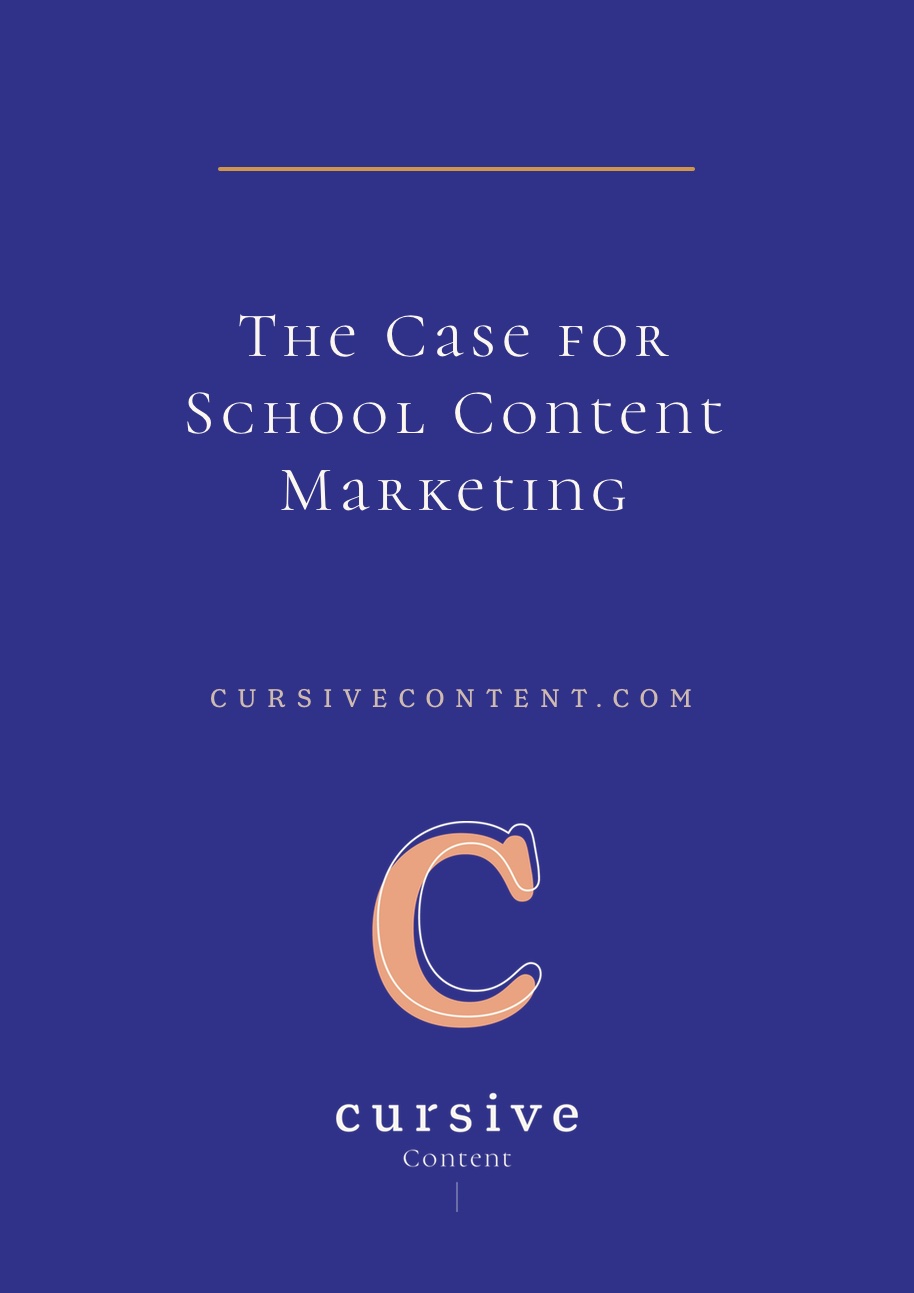The Case for School Content Marketing

As a school marketing professional, you probably find yourself having to “make the case” for many of your strategies, tactics, and creative ideas.
Why did you choose this direction? How much will it cost in both time and resources? What’s the expected ROI? And most important, will it turn more of our dream families into enrolled families?
Well, friends, we’re here to help.
If you’re ready to move your school away from traditional, underperforming school marketing campaigns and reallocate your budget and time toward new content marketing initiatives, this post will give you all the ammunition you need to make the case for content.
New: Audience-First School Storytelling Kit
Want to learn exactly how to win over dream families with breakthrough school storytelling? This on-demand kit includes instant access to:
- In-depth video workshop
- Workshop workbook
- Family survey template
- Email template
- Voice of Customer research spreadsheet
- Audience persona template
- Sample dream family persona
Many school marketers who have recognized the undeniable benefits of content marketing are now faced with the often-difficult task of convincing their school leadership, Board of Trustees, or even their own school marketing team that committing to a long-term content marketing strategy is critical.
So where do you begin? Let’s start by giving your team an introduction to the basics:
What is content marketing?
Content marketing is owning — and opposed to renting — media. It’s a marketing process to attract and retain customers by consistently creating and curating content in order to change or enhance a consumer behavior. — Joe Pulizzi
I like this definition because it combines two essential components of content marketing in one concise statement:
- Content marketing is all about owning content. When you invest in smart content development, you’ll benefit from that investment long term. Evergreen content can continue to attract new families to your school long after your initial share.
- The purpose of content marketing is to change or enhance consumer behavior. Creating content alone is not content marketing. Your content has a job to do. It needs to attract and retain new families, and get them to take action. If it’s not … you need a better plan.
What does school content marketing look like?
A simple way to think about content marketing is that it will require your school to create original content or share existing content that will benefit your audiences (current families, to dream families, to alumni, to donors, to your own faculty and staff, etc.,); develop an appealing hub for your content in the form of a blog, video library, podcast, news section on your website, etc.; and then use smart marketing strategies to get your audiences to engage with your content and take specific actions.
How is school content marketing different than a traditional school marketing campaign?
Content marketing is different than a traditional marketing campaign (such as a print ad, radio or television commercial, or printed mailers or brochures) in that content marketing is not a campaign – it’s an ongoing initiative that evolves over time, constantly being adjusted to meet new goals based on metrics and measurement.
Content marketing is a continuum: you own your content and can repurpose it to continuously attract and engage audiences. Traditional marketing campaigns have a start and end: when they’re over, they’re over.
With content marketing, you earn your audience — and therefore own your audience. With traditional marketing, you “rent” someone else’s audience and pay to have your message delivered.
Content marketing strategies are based on real-time metrics. They’re easier to test and refine tactics in real-time. Traditional campaigns can be high risk; they are measured at the end of the program and subsequent campaigns are modified.
With content marketing, ROI can be realized right away. With traditional marketing, ROI is often difficult to quantify.
Content marketing can form the foundation of all of your school’s digital marketing moving forward. Traditional marketing requires more cost and creative to cross-market channels.
Content marketing creates a shared experience between your school and your audience. Traditional marketing is usually a one-sided push of information, from your school to your audience.
How can your school adopt a content marketing plan in phases?
A phased approach to implementing a content marketing plan can be a smart way for your school to begin to move away from any stagnant traditional marketing campaigns. Here’s how to ease into content marketing:
#1: Devise your strategy. Strategy should always come first. Formulate a plan that encompasses:
- Short- and long-term goals
- Dream family personas
- Competitive analysis
- Strategies and tactics, based on goals and audience
- Metrics for each tactic
#2: Break it down. Now that you have your overarching strategy and time table, you can prioritize. When evaluating what should come first, consider:
- Resources: Do you have the ability to fully commit to this strategy/tactic?
- Urgency: Is there anything else driving this strategy/tactic that should be considered?
- Impact: Is this strategy/tactic likely to make the most impact? Could implementing this immediately make it easier for you to see future success in other areas?
- Related efforts: Do you need to change or implement any other strategies/tactics at the same time as this one?
- Time: Is it realistic to expect to see an impact within the time period you have allotted for this pilot program initiative?
#3: Determine metrics.
- Compile the metrics for each strategy and tactic so you know exactly what needs to be tracked.
- Gather any benchmark data and record it for future reference.
- While vanity metrics (likes, shares, etc.) might play a role, make sure to go beyond them to more meaningful metrics such as subscribers, inquiries, visits, and of course enrollment.
#4: Review and adjust. At the end of the pilot period, review both your progress and your efforts.
- Did you commit as fully as you intended? What adjustments can you make to be even more successful? What comes next?
- Go back to that content marketing strategy and see where you should start building on what you initially implemented.
What are the benefits of content marketing for schools?
Smart content marketing can increase:
- Brand loyalty
- Social engagement
- Search rankings
- Site traffic
- Public and key influencer trust
- Position as a thought leader
- Student and family satisfaction
- Organizational buy-in
- Conversion rates
Why is content marketing successful?
Because it’s authentic. When content marketing is done correctly, it’s interesting, informative, entertaining … and a sales tool. It forms real and trusted relationships with your school by lowering the advertising curtain and allowing the true school voice to speak for itself.
With content marketing, your school story is central to the practice.
And that’s why I love it. Traditional marketing campaigns are often more tactic-driven than story-driven. With content marketing, you’re focused on creating and sharing stories your audience will love. And what’s better than that?
Need more help making the case for content to your school leadership? Book a free discovery call and let’s begin to set your strategy.
MORE ARTICLES
-
 How to Support Your School Story with Organic, Authentic Social Media
How to Support Your School Story with Organic, Authentic Social Media -
 What Is Your Private School’s Bold & Unifying Big Promise?
What Is Your Private School’s Bold & Unifying Big Promise? -
 AI Writing Prompts to Power Private School Storytelling
AI Writing Prompts to Power Private School Storytelling -
 When to Outsource Your Private School Content Marketing to an Expert
When to Outsource Your Private School Content Marketing to an Expert -
 3 Unique Ways to Attract Dream Families with Content
3 Unique Ways to Attract Dream Families with Content -
 How to Attract Dream Families with Unforgettable Private School Social Media Advertising
How to Attract Dream Families with Unforgettable Private School Social Media Advertising -
 How to Write a Compelling School Magazine Article People Want to Read
How to Write a Compelling School Magazine Article People Want to Read -
 4 Quick & Easy Ways to Improve Your School’s Emails
4 Quick & Easy Ways to Improve Your School’s Emails


